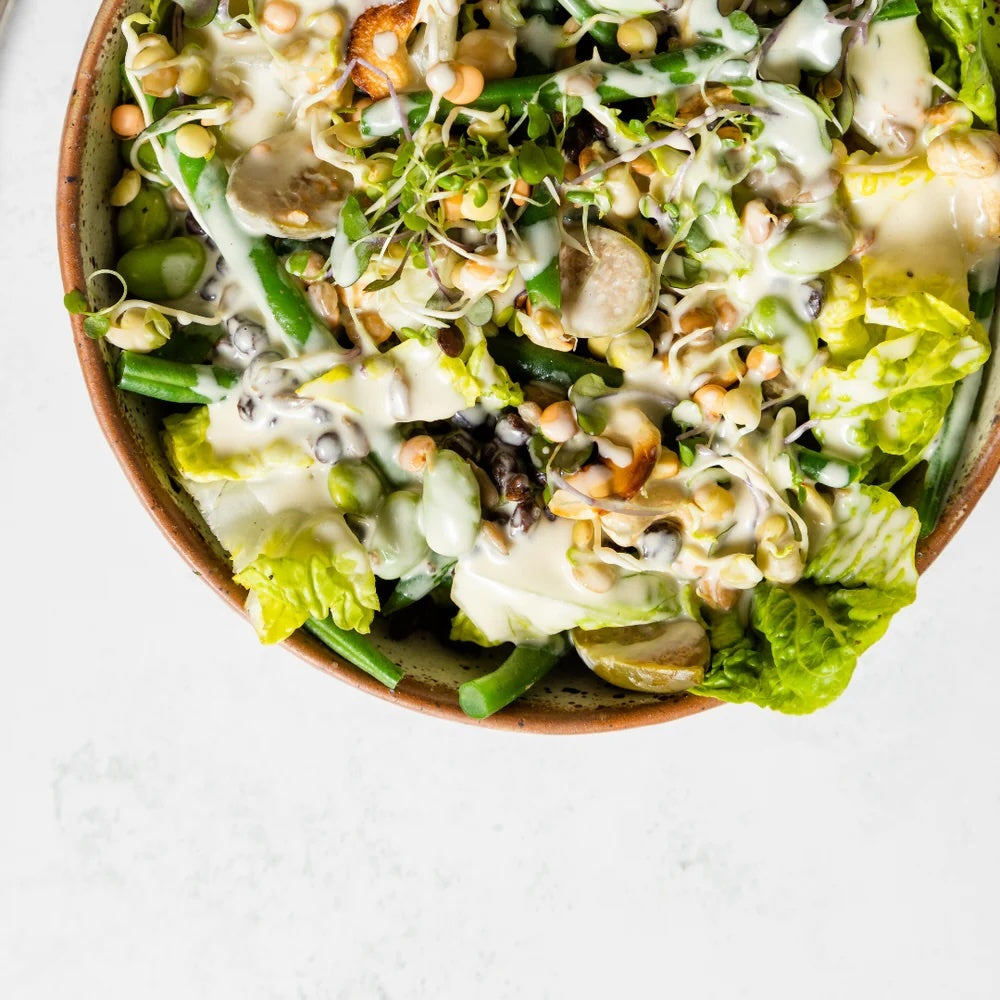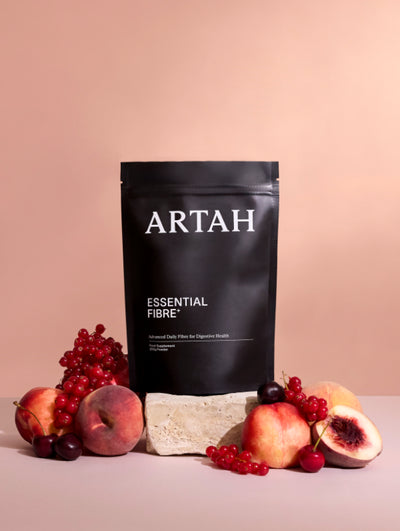Glucagon-like peptide 1, or GLP-1, is a naturally produced hormone that has several roles important to health and metabolism. It triggers insulin release from the pancreas to help regulate blood sugar, it slows gastric emptying, helping us feel full for longer, and it increases our feelings of satiety (fullness) after by influencing the area of our brain that is responsible for hunger signals.
The hugely popular weight-loss injections are known as GLP-1 agonists; in other words, they mimic the natural actions of GLP-1. Whilst these drugs can be life saving for individuals who need them, their off-label use for those who don't is still causing concern.
The good news is this: there are a variety of ways we can harness our body’s natural production of GLP-1, and they can be game-changers. From foods, and herbs to exercise and hacks - here’s what you can do if you’re looking for natural strategies to cultivate healthy levels of GLP-1. It’s important to note that these should not be a substitute for medications when they are needed.
Be strategic with food.
There are two trending categories of food that have an undeniable effect on GLP-1 levels; fibre and protein. (1,2)
GLP-1 loves fibre, but before we go into why, let’s do a quick review. There are two types of fibre – soluble fibre and insoluble fibre. Fibre has various benefits, depending on the type, but all fibre is good fibre, and we need a variety of sources to get the full spectrum of benefits. Some types resist fermentation in the colon and therefore provide a bulking action to our stool; these mainly assist with regularity. Others are readily fermented by the microbiome and produce compounds that are beneficial to immunity, glycaemic control and appetite; these fibres have more of an overall metabolic benefit, whilst still helping us in the regularity department. Fibre may be one of the most important components of a healthy diet, but in general, we aren’t getting enough. The British Dietetics Association reports that the average adult in the UK gets 18g of fibre out of a recommended 30g, only 60% of the minimum recommended intake (3). If we’re thinking in terms of the optimal amount – this number is even more concerning. Fibre’s action on GLP-1 helps us feel full, so increasing our intake is a quick win when it comes to metabolic health. (4) Here are some of our favourite fibre-rich foods:
-
Beans + lentils – serving up a whopping 12-15g per 1 cup cooked
-
Chia seeds – 10g per 2 tbsp
-
Green Peas – 9g per cup
-
Squash – 9g per cup
-
Raspberries – 8g per cup
-
Jumbo oats – 8g per ½ cup of uncooked oats.*
-
Avocado – 7g per half/14g in a whole fruit
-
Almonds – 6g per half cup
-
Artichoke hearts – 5g per half cup serving
-
Psyllium husk – 5g per tbsp
* Using raw oats in the form of overnight oats is a great way to decrease the glycaemic load and increase fibre, resistant starch and protein of your breakfast rather than having them cooked
The next category of food is protein. Like fibre, protein intake is associated with better satiety and appetite regulation. (2) Studies have shown that when you control for calories, meals high in protein result in higher levels of GLP-1 both after eating and throughout the day, compared to meals high in fat or carbohydrate. (5) To reap the full benefits of this, try front loading your day with protein (i.e. breakfast), which can help balance appetite, energy, and food intake for the rest of the day. How much is enough? The minimum advice on protein intake is 0.8g per kg of body weight, but optimal intake (especially for those who are active) may be quite a bit higher; try aiming for 1.2g per kg of body weight.
Use functional herbs.
A variety of herbs and phytonutrients have also been shown to support healthy GLP-1 levels, including Berberine, Curcumin, Cinnamon, Resveratrol, and Panax Ginseng. (6) Berberine, for example, has been shown to increase GLP-1 secretion by altering the microbiome and its metabolites. (7) Where to find them:
-
Panax Ginseng and Resveratrol are found in Enhanced NAD+ Complex, our longevity hero which also supports nutrient sensing pathways by boosting levels of NAD+.
-
Berberine, Green Tea and Cinnamon are all found in our cult favourite Metabolic Fix, which also contains Alpha-Lipoic Acid and N-Acetyl Cysteine, two of our most potent and biologically important antioxidants.
Use these hacks.
Whilst research is still young in the area, it’s believed that microbes in our gut play a role in mediating GLP-1 production, mainly through their effect on short chain fatty acid (SCFA) production. (8) SCFAs have numerous metabolic benefits, from warding off inflammation and improving mineral absorption to immune modulation and gut wall integrity, and certain species of bacteria, like Lactobacillus and Bifidobacterium, are known to produce SCFA as metabolites. (8) Because of this, certain probiotics and fermented foods are the focus of interest in numerous studies relating to GLP-1. More human studies are needed, however studies in mice have shown that adding a daily dose of Kombucha significantly increased GLP-1 secretion after 4 weeks fo use. (9) Other fermented foods like sauerkraut, kefir, natural pickles and kimchi are also associated with SCFA production, so including them in our weekly regime is a must.
Exercise is another hot area of interest. We already know that exercise can improve glucose tolerance, mood, and disease risk, so we shouldn’t need another proof point as to why it’s important. But, here is one anyways. In one study, both acute exercise, like HIIT, and endurance training significantly increased GLP-1 production. (10) This isn’t the only way exercise can benefit appetite regulation; it can also suppress Ghrelin (our hunger hormone), increase PYY (another ‘fullness’ hormone), and of course, relieves stress, which may have a knock-on effect on healthy eating behaviours. (11)
Disclaimer: The information is presented in this article is for educational purposes only and is not intended to diagnose, prevent, or treat any medical or psychological conditions. The information is not intended as medical advice, nor should it replace the advice from a doctor or qualified healthcare professional. Please do not stop, adjust, or modify your dose of any prescribed medications without the direct supervision of your healthcare practitioner.
References.
-
Karaki S-I, Tazoe H, Hayashi H, Kashiwabara H, Tooyama K, Suzuki Y, Kuwahara A. Expression of the short-chain fatty acid receptor, GPR43, in the human colon. J Mol Histol. 2008;39:135–42. doi: 10.1007/s10735-007-9145-y
-
van der Klaauw, A.A., Keogh, J.M., Henning, E., Trowse, V.M., Dhillo, W.S., Ghatei, M.A. and Farooqi, I.S. (2013), High protein intake stimulates postprandial GLP1 and PYY release. Obesity, 21: 1602-1607. https://doi.org/10.1002/oby.20154
-
https://www.bda.uk.com/resource/fibre.html#:~:text=How%20much%20fibre%20should%20I,aim%20for%2015g%20per%20day.
-
Nøhr MK, Pedersen MH, Gille A, Egerod KL, Engelstoft MS, Husted AS, Sichlau RM, Grunddal KV, Poulsen SS, Han S, Jones RM, Offermanns S, Schwartz TW. GPR41/FFAR3 and GPR43/FFAR2 as cosensors for short-chain fatty acids in enteroendocrine cells vs FFAR3 in enteric neurons and FFAR2 in enteric leukocytes. Endocrinology. 201Cummings DE, Overduin J. Gastrointestinal regulation of food intake. J Clin Invest 2007; 117: 13-23
-
Xu S, Wang Y, Wang J, Geng W. Kombucha Reduces Hyperglycemia in Type 2 Diabetes of Mice by Regulating Gut Microbiota and Its Metabolites. Foods. 2022 Mar 5;11(5):754. doi: 10.3390/foods11050754. PMID: 35267387; PMCID: PMC8909623.
-
Yaribeygi H, Jamialahmadi T, Moallem SA, Sahebkar A. Boosting GLP-1 by Natural Products. Adv Exp Med Biol. 2021;1328:513-522. doi: 10.1007/978-3-030-73234-9_36. PMID: 34981502.
-
Araj-Khodaei M, Ayati MH, Azizi Zeinalhajlou A, Novinbahador T, Yousefi M, Shiri M, Mahmoodpoor A, Shamekh A, Namazi N, Sanaie S. Berberine-induced glucagon-like peptide-1 and its mechanism for controlling type 2 diabetes mellitus: a comprehensive pathway review. Arch Physiol Biochem. 2023 Nov 3:1-8. doi: 10.1080/13813455.2023.2258559. Epub ahead of print. PMID: 37921026.
-
Zeng Y, Wu Y, Zhang Q, Xiao X. 2024. Crosstalk between glucagon-like peptide 1 and gut microbiota in metabolic diseases. mBio 15:e02032-23.
-
Xu S, Wang Y, Wang J, Geng W. Kombucha Reduces Hyperglycemia in Type 2 Diabetes of Mice by Regulating Gut Microbiota and Its Metabolites. Foods. 2022 Mar 5;11(5):754. doi: 10.3390/foods11050754. PMID: 35267387; PMCID: PMC8909623.
-
A. Holliday, A. Blannin. Appetite, food intake and gut hormone responses to intense aerobic exercise of different duration. J. Endocrinol., 235 (2017), pp. 193-205
-
Caruso L, Zauli E, Vaccarezza M. Physical Exercise and Appetite Regulation: New Insights. Biomolecules. 2023 Jul 27;13(8):1170. doi: 10.3390/biom13081170. PMID: 37627235; PMCID: PMC10452291.



















































